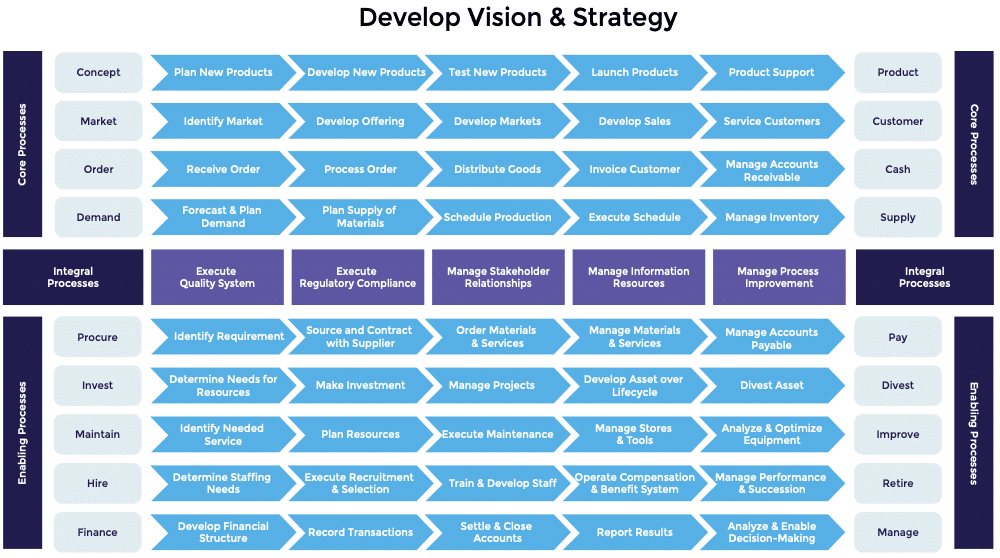ERP Readiness Series: The Four Core Processes Every Business Should Document
In this latest installment of our ERP Readiness series, we take a close look at a comprehensive business process model and how we use it to orient clients to a process readiness conversation. It starts with this chart . . .
The graphic, above, is the comprehensive business model we use when talking to clients about process readiness. It ensures everyone at the table has a common vocabulary when discussing common business process without being overly prescriptive. At the end of the day, every business must pay attention to many, if not all, of these processes in order to succeed. Whether documented and well-planned-out or ad hoc and seat-of-the-pants, these business processes are what businesses do.
Orientation to the Model
“Develop Vision and Strategy” appears at the very top of the model. First and foremost, all business processes derive from and, in turn, support a well-developed company vision and strategy. From there—and particularly before you begin any major change initiative—making sure you have a plan and a roadmap for using company resources well is really important. Take the time to build your roadmap to the future, one that is grounded in your strategic objectives, company culture, and utilizes your people, processes, and technology, and you’ll have a foundation from which to grow. We have a video that walks organizations though the creation of an enterprise resource strategy. Most of the concepts introduced in the video apply to general business strategy, not just planning for ERP.
Next, you’ll notice nine separate blue “swim lanes” with arrows pointing from left to right. Each of these swim lanes describes, in broad terms, one business process. One process that we have repeatedly used as an example in this blog is the order-to-cash process (the third swim lane down). On the left side of the model is Order, on the right is Cash, thus the five steps in between describe the steps taken in the process to turn a customer order into cash in the bank. The steps are as follows:
- Receive Order
- Process Order
- Distribute Goods
- Invoice Customer, and
- Manage Accounts Receivable.
Similarly, there are five steps between concept and product that make up the concept-to-product process, five in the market-to-customer process, and so on.
Each of these five steps are intentionally broad. Each step may or may not involve one or more sub-processes. For example, receiving an order may be as simple as getting a phone call, email, fax, or webform while processing the order may involve multiple steps in a spreadsheet or accounting program. Two businesses may differ in how they execute each of the steps in the order-to-cash process, but both businesses will have an order-to-cash process that conforms in some way to these five steps.
The Four Core Processes
The first four processes are those we consider to be the Core Processes of any business. These four business processes are the revenue generators for your business:
- Concept-to-product
- Market-to-customer
- Order-to-cash, and
- Demand-to-supply
All four processes must be in place for a business to be profitable. As such, it is vital for an organization to be crystal clear about how these processes are executed on a day-to-day basis. If your business chooses not to document all nine business processes, we strongly recommend that you document at least these core four processes to foster clarity across the organization. Along the way, you will no doubt identify inefficiencies that you can work to improve.
The Supporting Cast
The next five processes are we call the Enabling Processes. These five processes do not generate revenue in-and-of themselves. However, the five enabling processes provide critical support for the four core processes that do. The five enabling processes are:
- Procure-to-pay
- Invest-to-divest
- Maintain-to-improve
- Hire-to-retire, and
- Finance-to-manage
The fact that these five processes are listed under the four core processes is not in any way intended to imply that these five processes are less important. On the contrary, these processes are under the four core processes because they are foundational. If the enabling processes are efficient, robust, and clear it is almost always the case that valuable resources are freed-up to pursue the four core processes more aggressively. Said differently, businesses that spend the time documenting and streamlining their enabling processes are able to scale faster and become more competitive in their marketplaces than businesses that do not.
Bubble Wrap for Your Company
The model contains one final piece to consider. There is a series of orange boxes that represent what we call Integral Processes. These five processes are not sequential in the same way that the core and enabling processes are. Rather, the integral processes serve to integrate the core processes with the enabling processes and vice versa—the glue between the two kinds of processes, if you will. Executing quality systems and regulatory compliance and managing stakeholder relationships, information resources, and process improvements are done across all core and enabling processes. They run vertically across the model. Integral processes serve and protect the entire organization; they help to manage risk and enable things to run more smoothly. Think of integral processes like the bubble-wrap around an important parcel shipped across the country.
In future posts, we will discuss how to conduct a readiness assessment and continue to flesh out this model. We will consider how it can be used to support organizational transformation initiatives like technology and enterprise solution changes or how it might be used to create a continuous improvement culture within your organization.
To help you go through this process, we’ve created the ERP Readiness Self-Assessment — a PDF you can download and print, or fill out right on your computer. Download your complimentary copy right here.
ERP Readiness Self-Assessment
Is your organization ready for a new or upgraded ERP solution? Find out with this complimentary self-assessment.
Doing Business Better
You strive for excellence, believe in your people, and want to do things right the first time. And you know that you need help to get to the heart of your business challenges and make the best choices for the future of your privately held manufacturing and distribution company. That’s where we come in.
We help you focus and find exactly the right path to accelerated growth and sustainable success — from your people to your processes to your ERP software.



